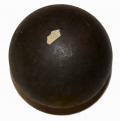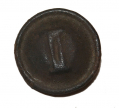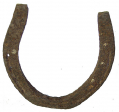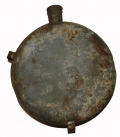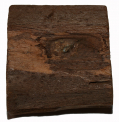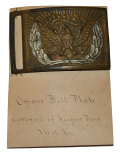site search
online catalog
Relics
Showing 101 to 120 out of 397
CONFEDERATE 3” MULLANE COMMON SHELL
Here is a fired Confederate 3” bourreleted Mullane Type 1 common shell recovered from an unknown battlefield location. Made for the 3” Ordnance Rifle. Also known as a “Tennessee Sabot”, this… (490-7005). Learn More »
U.S. / C.S. 12-POUNDER SOLID SHOT – FROM G.A.R. “SKELLY” POST #9, GETTYSBURG
This is the most common solid shot projectile of any caliber used during the Civil War by both the Federal and Confederate forces. This is a solid iron cannon ball with dark brown tone and smooth… (490-6993). Learn More »
RARE, EXCAVATED, CONFEDERATE 3” ARCHER BOLT WITH SABOT -- ANTIETAM
Here is an excavated, Confederate 3” field artillery projectile commonly referred to as an Archer Bolt. The design was likely produced by Dr. Robert Archer a partner of Joseph Anderson, the… (2024-1378). Learn More »
PRUSSIAN HIRSCHFANGER SWORD BAYONET FOR THE JAEGER RIFLE FROM THE YORK SPRINGS, PA, G.A.R. POST
This bayonet is in excavated condition, showing deep brown pitting and rust to the blade and green to the brass hilt. The spearpoint tip of the of flat, unfullered double-edged blade is bent, but the… (2023-2997). Learn More »
$295.00
SOLD
CONFEDERATE BLOCK “I” BUTTON FROM DANIEL LADY FARM IN GETTYSBURG
This is an excavated block “I” button; the “I” designating Infantry. This is constructed of a stamped brass face with a tin back. The shank is broken off. Nice dark brown patina on the brass;… (2024-1481). Learn More »
FIRED U.S. 3” HOTCHKISS CASE-SHOT
Offered here is a very nice excavated Union artillery shell that was fired and, partially, detonated. This is an iron, 3” Hotchkiss artillery shell that was intended to be fired from a 10-pounder… (490-7002). Learn More »
$895.00
SOLD
RELIC CONDITION HORSESHOE ONCE OWNED BY J. HOWARD WERT
Horseshoe is 7 inches long and 6 inches at the widest point. Heavy surface rust. Old catalog tag #70 at the top. At the time of the Gettysburg campaign, twenty-two year-old John Howard Wert was… (2024-1640). Learn More »
ANTIQUE BROAD AXE HEAD FROM FREDERICKSBURG
The Fredericksburg area was filled with army camps on both sides of the river and tools like this were needed for the construction of winter huts as well as cutting trees for firewood and field works.… (2023-3257). Learn More »
EXCAVATED BAYONET TURNED POTHOOK FROM A CIVIL WAR CAMP- EX TEXAS MUSEUM
A bayonet with the blade bent into a hook was a simple and serviceable way to get a camp kettle or coffee pot off a blazing campfire or out of the fireplace in the hut of a winter camp. Needless to… (1179-1241). Learn More »
$225.00
SOLD
RELIC M1839 U.S. INFANTRY WAIST BELT PLATE – 1ST CORPS FIELD HOSPITAL, GETTYSBURG
Offered here is a relic of the Battle of Gettysburg. This is an oval U.S. waist belt plate. This piece is in “farm field, relic” condition and was recovered long ago by a local relic hunter. The… (2024-1464). Learn More »
EXCAVATED CIVIL WAR BRITISH IMPORT SWORD BAYONET FOR THE ENFIELD SHORT RIFLE
This is a good, excavated example of the British sword bayonet for the short rifle, imported by both sides in the Civil War. The blade has no bends or breaks and is missing just a small bit of the tip… (1179-1237). Learn More »
SOUVENIR RELIC RING FROM FISHER’S HILL BATTLEFIELD
This ring is accompanied by short presentation note signed by Mr. Joseph Fisher of Strasburg, Va. The note indicates it was “made from a cap of a shell (?) found on Fisher’s Hill Battle-Field… (846-424). Learn More »
DROPPED US .54 CAL. MINIE BALL RECOVERED ALONG TANEYTOWN ROAD, GETTYSBURG – KEN BREAM COLLECTION
These Minie balls were found by local Gettysburg resident and relic hunter Ken Bream. Mr. Bream was born and raised in Gettysburg and grew up in a house right next to the famous Peach Orchard. He… (1163-50). Learn More »
US CAVALRY MANN’S PATENT CARTRIDGE BOX EX-LEES HQ MUSEUM
The Mary Thompson house at Gettysburg, used by Lee as his headquarters at Gettysburg, was recognized by its owner in the 1890s as a valuable battlefield relic, perhaps a particular attraction for… (224-750). Learn More »
US GENERAL SERVICE EAGLE COAT BUTTON RECOVERED AT 3RD CORPS HOSPITAL SITE, GETTYSBURG – KEN BREAM COLLECTION
Dark chocolate patina; has some damage to face – a crack and a few small holes. Some verdigris present. Shank present; more verdigris on reverse. There appears to be a backmark present but it is no… (1163-198A). Learn More »
CONFEDERATE “PIE-PLATE” TIN DRUM CANTEEN
This is an interesting variation on the tin drum canteens that became very popular in the 1850s following the adoption of round drum-shaped tin canteen with convex sides by the US Army in 1836, though… (490-6762). Learn More »
BULLET IN WOOD FROM CULP’S HILL, GETTYSBURG
This is a solid piece of a tree with a bullet fired into it. This small piece of wood has an unknown type minie ball embedded in it; just the back end is visible. This is an old piece of wood, cut… (2024-1280). Learn More »
$395.00
SOLD
WOOD REMOVED FROM LEE’S HEADQUARTERS AT GETTYSBURG
This piece of wood is nicely matted and framed in a Riker mount along with a photo of Lee’s headquarters soon after the battle and a display label. This comes from the Thompson house, built in 1833,… (1251-74). Learn More »
$185.00
SOLD
MODEL 1851 SWORD BELT PLATE FROM HARPERS FERRY ON A GREAT DISPLAY CARD
This sword belt plate, a very good example of an early pick-up, is mounted on a great old card typical of early relic displays labeled in brown ink, “Officers Belt Plate / battlefield of Harpers… (1202-196). Learn More »
CIVIL WAR NORTH CAROLINA STATE SEAL BUTTON WITH STAR BACKMARK, TRACES OF SILVER
Civil War North Carolina state seal button with “NORTH CAROLINA” along the top edge and figures of Liberty and Plenty at center. Unmarked, but with small single star in the channel on the back.… (2024-703). Learn More »
Showing 101 to 120 out of 397
Most Popular
Historical Firearms Stolen From The National Civil War Museum In Harrisburg, Pa »
Theft From Gravesite Of Gen. John Reynolds »
Selection Of Unframed Prints By Don Troiani »
Fine Condition Brass Infantry Bugle Insignia »
British Imported, Confederate Used Bayonet »
Scarce New Model 1865 Sharps Still In Percussion Near Factory New »
featured item
EXCELLENT CONDITION EARLY MARINE MAMALUKE WITH IVORY GRIP AND ENGRAVED SCABBARD
Manufactured: U.S. Maker: Unmarked Year: C1820-25 Model: Mamaluke Size: 29.25 inch blade 1.30 in. wide Condition: Excellent+ Sharply curved, single edged, blue and gold engraved blade decorated with ships mast, Indian with headdress, arms,… (870-72). Learn More »
site search
Upcoming Events
APRIL 12-13: SPRING GETTYSBURG MILITARY ANTIQUES SHOW; All Star Events Complex Learn More »




